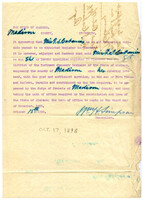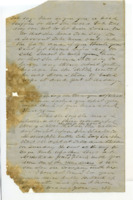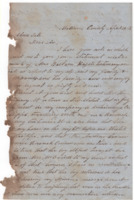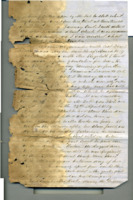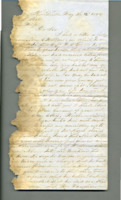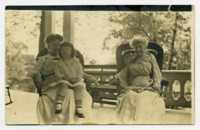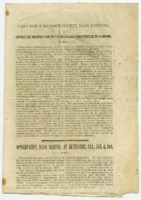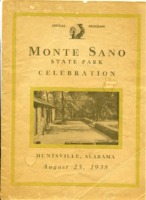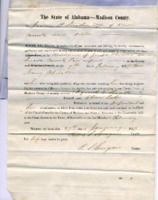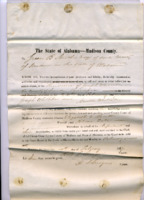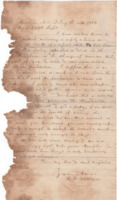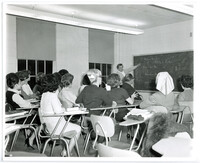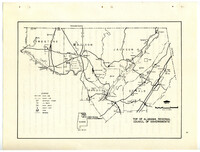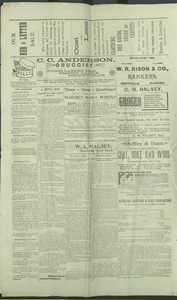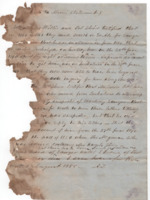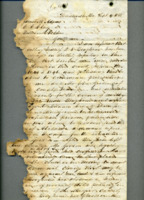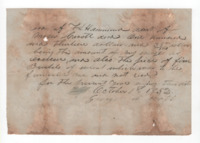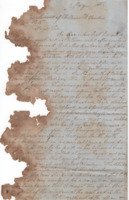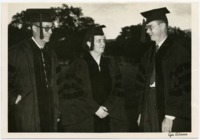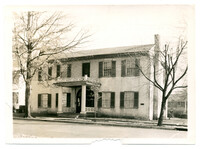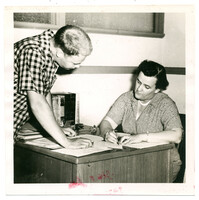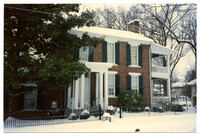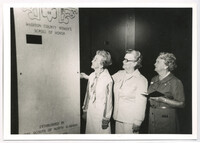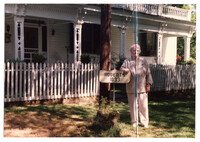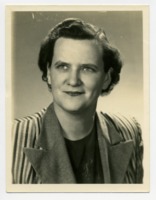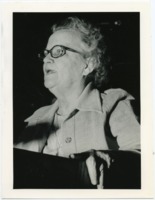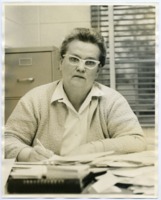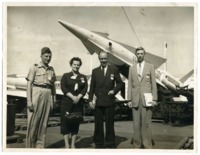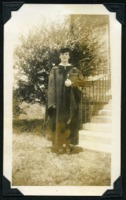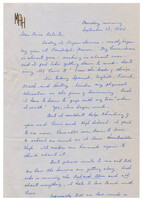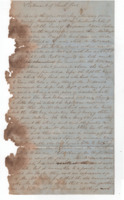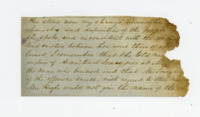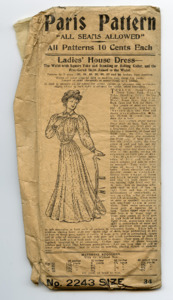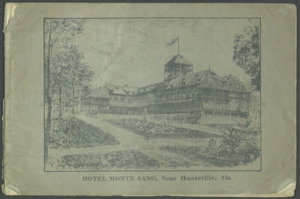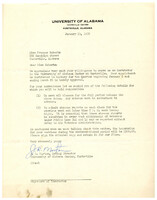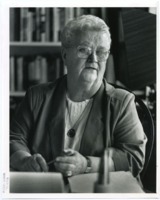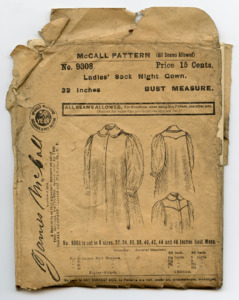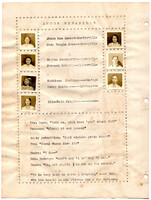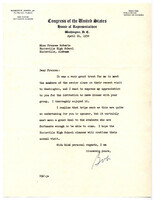
Browse Items (55 total)
Sort by:
-
Partial deposition and court questions.
This page is most likely missing a few pages. The front details someone's statement, though the author is unknown. It tells of phrases spoken by Abner Tate that were overheard by Mrs. Hazel. The botton of the page inquires what the author/interviewee would think if they heard such phrases. The last line appears to have the initials S. D. G. that may be the author of the page. The back side includes questions 13 through 18 that were most likely asked in court. -
Letter to Abner Tate.
The letter to Abner Tate addresses the testimony of Barbara Hazel, confirming some parts but refuting more of it. It is clear that pages of the letter are missing as it ends in the middle of a sentence and has no author's signature on any page. Note: This could be Moore's statement which would match with the Note to Moore's Statement. -
Testimony of a Resident of Elizabeth Routt as Requested by Abner Tate.
The author of this written statement is illegible. It appears that the first name of the author may be Francis but it being so faded, is difficult to discern. The author does state that he was living with Elizabeth Route at the time and managing her plantation, during which he became aquainted with Daniel H. Bingham. The written statement, recorded as the author was "called upon by Mr. Tate to state what my testimony was upon his trial...", details the interaction of the author with Bingham, who wished to marry Mrs. Routt, and Mrs. Routt, beginning in March 1854 through 1855. -
Letter Regarding the Case and Barbora Hazle's Statements.
This letter, written on May 12, 1856, has several names that are illegible, including the author's. It is addressed to two men, the first being [Daniel] P. Pool, and is a lengthy letter in response to a letter received from Abner C. Wellborn and in particular, the supporting testimony of Barbara Hazel accusing Abner Tate of at least two murders. The author states that the credibility of Hazel's words should be questioned due to the several reasons he goes on to detail. Following the original letter, the author pens an amendment to include changes that occured since the original letter was written as Tate had made a recent publication during that time. -
Postcard of a woman, possibly Virginia Clay-Clopton, and companions.
The back of this real photo postcard reads, "Virginia Clay Clopton, age 90." -
"Call for a Madison County Mass Meeting, to Oppose the Ratification of the So-Called Constitution of Alabama."
This broadside was published by conservative Alabamians in opposition to the 1868 Alabama constitution, known as the "Reconstruction Constitution." The constitution was revised by the constitutional convention on November 5, 1867, and ratified in 1868. -
Official program of the Monte Sano State Park Celebration.
This celebration was held on the park's opening day. Events included a parade, an address given by Speaker of the U.S. House of Representatives William B. Bankhead, a history pageant, and a "Queen's Ball" that evening at the Russel Erskine Hotel. The program includes a description of the cabins, the "Legend of Monte Sano," a history of Huntsville, and a program for the history pageant, titled "The Parade of Progress." -
Deposition of Nancy Whitaker.
Nancy Whitaker acted as a witness for the defendant, Abner Tate. Nancy responds to questions about Alexander Jeffries, her father, and Elizabeth Routt. She expresses her belief that her father was poisoned by Routt though she was not present until the morning after he died. Nancy details the dark color of her father's body and how it was swollen and "unnatural" in appearance. She also includes the rumors she has heard regarding several charges brought against Routt. She concludes by stating that it is her opinion that Routt is guilty in the case of her father's death. -
Depositions of Joseph Whitaker and Newton Whitaker.
The Whitakers were witnesses for the defendant, Abner Tate. Joseph Whitaker's deposition is first. He answers questions regarding Elizabeth Routt and her husbands, particularly the death of Alexander Jeffries. Joseph states that it is his opinion that Jeffries was poisoned. He also states that rumors have spread that she had ordered a slave to murder Abner Tate. Newton Whitaker's desposition is second. He also answers questions regarding Elizabeth Routt and her husbands, including the death of Alexander Jeffries. Newton states that he is also of the opinion that Jeffries was poisoned. Like Joseph, he also adds that she is said to have destroyed the lives of her husbands, stole cotton, and sought to harm Abner Tate. -
Letter from H. G. Wellborn to her uncle.
Wellborn writes to her uncle requesting information on the case of her "Pa", Abner Tate, who was arrested and tried for murder. She informs her uncle that there was a supposed detailed report in a Huntsville publication but couldn't get her hands on a copy. She concludes by writing of their temporary living arrangements just outside of Memphis, Tennessee. -
"Frances Cabaniss Roberts: Her Life and Legacy."
This virtual talk includes a lecture from Dr. Tom Reidy, editor of the 2020 edition of Frances Roberts' 1956 dissertation, with comments and moderation by UAH Head of Archives and Special Collections Reagan Grimsley and History Department Chair Stephen Waring. The talk was given as part of an Alabama Humanities Alliance grant, in partnership with the UAH M. Louis Salmon Library, the UAH Humanities Center, and the UAH History Department. -
W.L. Halsey and C.H. Halsey grocery store advertisements, 1896.
This is an image of page six of the Weekly Mercury from July 1896. W.L. Halsey and C.H. Halsey advertisements for their grocery stores are featured on this page. Other advertisements on this page include "C.C. Anderson Druggist", "W.R. Rison & Co. Bankers", "Sheffey & Dean", and "Herstein & Lowenthal, Proprietors." -
Note to Moore's Statement.
The Note to Moore's Statement was signed A.T., alluding to the possibility that Abner Tate wrote this. The note discusses the testimony of Mrs. Willis and Colonal Sheid regarding a search for Sawyer, one of the murdered men. It traces Sawyer's known whereabouts prior to him going missing. The note claims that A.T. had never heard of Sawyer or Rein, the second victim, until August 1855. -
Letter to James M. Adams, C. C. Clay, and William Acklen from Abner Tate.
This letter, written on September 4, 1855, contains information regarding several murders the occurred at the [sic] House between 1841 and 1846, as reported by D. H. Bingham. He further details the arrest and imprisonment of a Mr. John Gordon in relation to the murders, and his appearing in court. Possible information regarding the burial of the murdered men are offered in the letter as well. The letter ends with Abner Tate discussing the validity of certain confessions as many "delight" in "destroying the reputations of others." -
Receipt of George W. Scott.
This receipt is from October 1, 1852 and notes Scott's wages and the price of wheat bushels. -
Statement of William W. Sanders addressed to Abner Tate.
In his statement, William W. Sanders details the day Mrs. Hazel claimed to have seen Sawyer's body being burned by Abner Tate's slaves. He tells of how she told the story to him and that he was surprised when she relayed everything to him. Sanders ends by stating he believes Mrs. Hazel charged a "man of excellent character". -
Frances C. Roberts at commencement at the University of Alabama.
This photo was taken at the time of Roberts' doctoral graduation from the University of Alabama in Tuscaloosa, Alabama. She was the first woman to receive a Ph.D. in history from the University of Alabama. On either side of her are Howard C. Elliot, Jr., Ph.D. in biochemistry, and Elmer Dean Calloway, Ph.D. in chemistry. -
Snapshot of the Weeden House.
The Weeden House is located at 300 Gates Avenue in downtown Huntsville. The house underwent restoration in the 1970s and is now a historic house museum and garden open to the public. -
Photograph of the Cabaniss House in the snow.
The house is located at 603 Randolph Avenue in downtown Huntsville. Frances Roberts lived there for much of her adult life. -
Photograph from the inaugural Madison County Women's Scroll of Honor ceremony.
Frances Roberts, shown at center, was named to the Madison County Women's Scroll of Honor in 1976. According to the Huntsville Times, recipients of the honor "are native to or identified most closely with Huntsville and Madison County and who have made significant contributions within their professional fields of activity or concern." Roberts was honored alongside Huntsville artist and poet Maria Howard Weeden (1847-1905). The award is a project of the Girl Scouts of North-Central Alabama. -
Frances C. Roberts at the time of her graduation from Alabama State Teachers College in Livingston, Alabama.
Roberts received a Bachelor of Science from Alabama State Teachers College in 1937. The college is known today as the University of West Alabama. -
Letter from Martha Holliman in Lynchburg, Virginia, to Frances Roberts in Huntsville, Alabama.
Holliman was one of Roberts' students at Huntsville High School. She describes her first days at Randolph-Macon College and thanks Roberts for her excellent teaching. -
Statement of Sarah Pool.
The statement of Sarah Pool tells of her encounter with Mrs. Hazel in 1845 in Mississippi. She details the "strange stories" told by Mrs. Hazel and how she accused Mrs. McDavid of stealing and had "opened her bundle," a reference made in William Conner's letter to Abner Tate, that supposedly contained some medicines. Mrs. Hazel then asked Sarah to convey the story to Mrs. McDavid to which Sarah said Mrs. McDavid acted surprised at the accusations. Sarah also tells how Mrs. Hazel spoke of Mr. Tate and his right hand man involved in the murder of a man who she could not name. -
Partial statement of John P. Pool.
In these pieces of John's statement, John corroborates that which his wife Sarah said in her statement. The small pieces of paper detail the strange stories told by Mrs. Hazel that were out of character and not representative of the people she spoke of. He also mentions what she stated of the murder of the man she cannot name and how a Mrs. Jones assisted by covering the "offensive smell." He also writes of Mrs. Hazel's accusations of Mrs. McDavid stealing her money and medicines. In the larger piece, John Pool brings up the porch location that she supposedly witnessed the murdered man from. -
Paris Pattern no. 2243, Ladies' House Dress.
Made for a size 34-inch bust, this house dress pattern includes pieces for "The Waist with Square Yoke and Standing or Rolling Collar, and the Five-Gored Skirt Joined to the Waist." The front of the pattern envelope lists all instructions for the construction of the garment as well as material required. The pattern pieces are unprinted. -
"HOTEL MONTE SANO, Near Huntsville, Ala."
This pamphlet announces the opening of the Hotel Monte Sano on June 1, 1887 and lists the manager as "Mr. S.E. Bates." The first section of the pamphlet includes a brief history of Huntsville and a description of the city's amenities. The author extolls the health advantages of Huntsville as "most healthfully situated at the base of Monte Sano" and describes the city's lack of recent disease outbreaks. The second section of the pamphlet details the Hotel Monte Sano's furnishings and amenities. The author emphasizes the "healthful" environs of the mountain and the hotel and includes letters from Huntsville's "eminent physicians" as testimonials. The pamphlet includes illustrations of scenes from Huntsville and Monte Sano. -
Letter from John R. Morton to Frances C. Roberts in Huntsville, Alabama.
The letter notifies Roberts of her appointment as an instructor in history at the University of Alabama Huntsville Center. Morton notes that Roberts was to receive an honorarium of $200 for teaching January 6-March 20, 1950. -
Photo of Frances C. Roberts.
Photo from the Huntsville Times. The photo was taken for an article about the honorary doctor of humane letters that Roberts received from UAH on December 12, 1993. -
McCall Pattern no. 9308, Ladies' Sack Night Gown.
Made for a size 32-inch bust, this nightgown pattern includes five pieces for the front, back, collar, sleeve, and sleeveband. The pattern does not include pieces for the yoke. The front of the pattern envelope lists the material required for each size, and the back describes garment construction. The pattern pieces are unprinted. -
Excerpt from the Livingston High School "Annus Mirabilis" yearbook, 1932.
This page includes the photo of Frances Roberts, who later became a UAH history professor and the namesake of Roberts Hall. Roberts was a Senior II, or a junior, in high school at the time of this yearbook's printing. -
Letter from Rep. Bob Jones in Washington, D.C. to Frances Roberts in Huntsville, Alabama.
In this letter, Jones thanks Roberts, then a history teacher at Huntsville High School, for the opportunity to meet her students on their recent trip to Washington, D.C.
